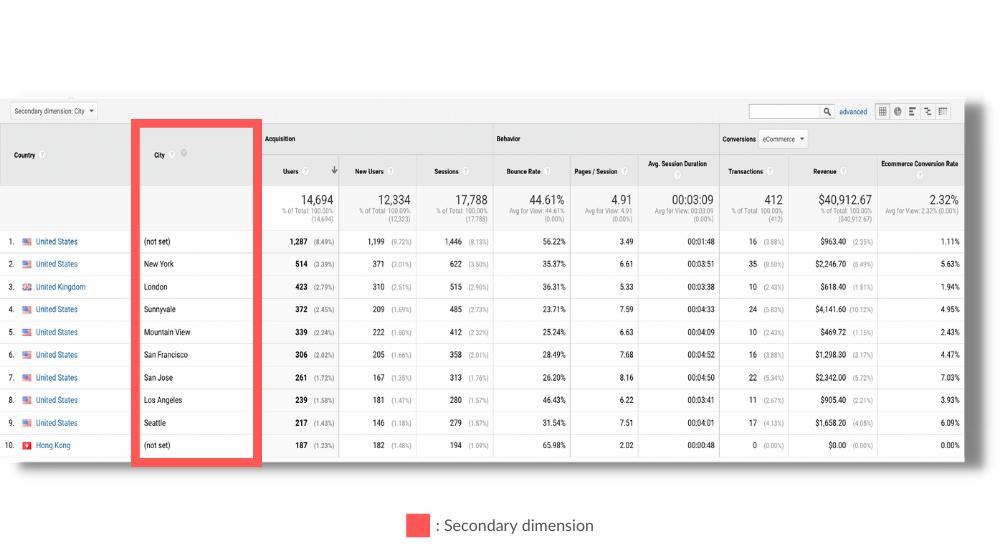Comprehending the Principle of a 'Secondary Dimension' in Google Analytics: What Does It Mean?
Comprehending the Principle of a 'Secondary Dimension' in Google Analytics: What Does It Mean?
Blog Article
Navigating the Midst of Secondary Measurement in Google Analytics: A Comprehensive Expedition on Its Performance
In the world of electronic analytics, the complexities of data analysis often hold the secret to opening valuable insights. Within the expansive toolkit of Google Analytics lies an attribute that works as a surprise gem for those that seek a much deeper understanding of customer habits and web site performance. Secondary measurements, though relatively uncomplicated at very first glimpse, harbor a riches of untapped possible waiting to be taken advantage of. As we get started on this trip to check out the nuanced performance of second dimensions, we will discover just how this attribute can brighten patterns, introduce correlations, and eventually lead the way for informed decision-making in the digital landscape.
Understanding Additional Dimensions in Google Analytics

Comprehending just how secondary measurements work is crucial for leveraging the full power of Google Analytics. By integrating primary metrics with additional measurements, you can gain important insights that drive informed decision-making and optimization strategies.
Leveraging Second Measurements for Data Analysis
Building upon the foundational understanding of just how additional measurements enhance data analysis in Google Analytics, the usage of these additional layers of information ends up being vital in extracting important understandings for educated decision-making and optimization strategies. By leveraging second measurements, analysts can dive deeper right into the performance metrics by including even more context to the key measurements, therefore revealing covert patterns and relationships that could not be apparent initially glance. This much deeper level of analysis enables services to much better understand customer behavior, determine fads, and pinpoint locations for enhancement.
Additionally, additional dimensions give an even more extensive view of the information, enabling division based on numerous criteria such as demographics, tools, web traffic sources, and a lot more. This segmentation assists in a much more granular analysis, enabling services to customize their projects and approaches to specific audience sections for boosted targeting and customization. In significance, the calculated use second dimensions encourages companies to make data-driven decisions that drive development and success in the digital landscape.
Advanced Techniques for Second Measurement Execution
Checking out complex methods to harness the full potential of second dimensions read the full info here in Google Analytics raises the depth and class of data analysis for strategic decision-making. One innovative technique for carrying out additional measurements is the use of personalized dimensions. Furthermore, combining second measurements with innovative segments can supply even much more granular insights by applying several layers of division to the data.
Interpreting Insights Through Secondary Dimensions

When translating insights with second measurements, it is vital to take into consideration the context of the data and how various measurements connect with each other. For instance, understanding which particular traffic sources result in higher conversion rates or recognizing which devices individuals favor for making purchases can offer actionable insights for maximizing advertising campaigns and improving general website performance. By carefully taking a look at the information with secondary measurements in mind, organizations can make informed choices that drive meaningful results and boost their digital visibility.
Optimizing Performance With Secondary Measurements
One vital method to optimize efficiency with second dimensions is by segmenting information extra granularly. This permits you to isolate particular variables that might be influencing your metrics and gain a better understanding of what drives success or failing in your electronic campaigns. For example, by incorporating additional dimensions such as 'device category' and 'landing page,' you can determine which gadget kinds are most efficient for certain touchdown web pages, allowing you to tailor your methods as necessary.
In addition, using additional measurements can assist you recognize trends, patterns, and correlations that might not be apparent when evaluating data with key dimensions alone. This deeper degree of analysis can bring about more educated decision-making and eventually boost the total performance of your website or electronic advertising campaigns.
Final Thought
Finally, secondary measurements in Google Analytics play a vital function in improving data analysis and giving much deeper insights into site performance. By making use of innovative strategies and translating the information effectively, businesses can optimize their approaches and improve overall efficiency. Comprehending the performance of additional measurements is crucial for making notified choices and driving success in the digital landscape.
By leveraging additional measurements, experts can dig much deeper into the performance metrics by including even more context to the primary measurements, thus discovering hidden patterns and relationships that could not be apparent at first glimpse. One advanced technique for executing secondary dimensions is the usage of custom-made measurements.Having actually mastered sophisticated methods like custom measurements and regex for secondary measurement execution in Google Analytics, the following vital action is translating the beneficial insights acquired with these innovative information division methods. Interpreting insights through second measurements entails evaluating the relationships between the second and main measurements chosen, uncovering patterns, trends, and connections that may not be immediately noticeable when looking at the data in its entirety.When analyzing insights with secondary dimensions, it is essential to think about the context of the information imp source and just how different measurements engage with each other.
Report this page